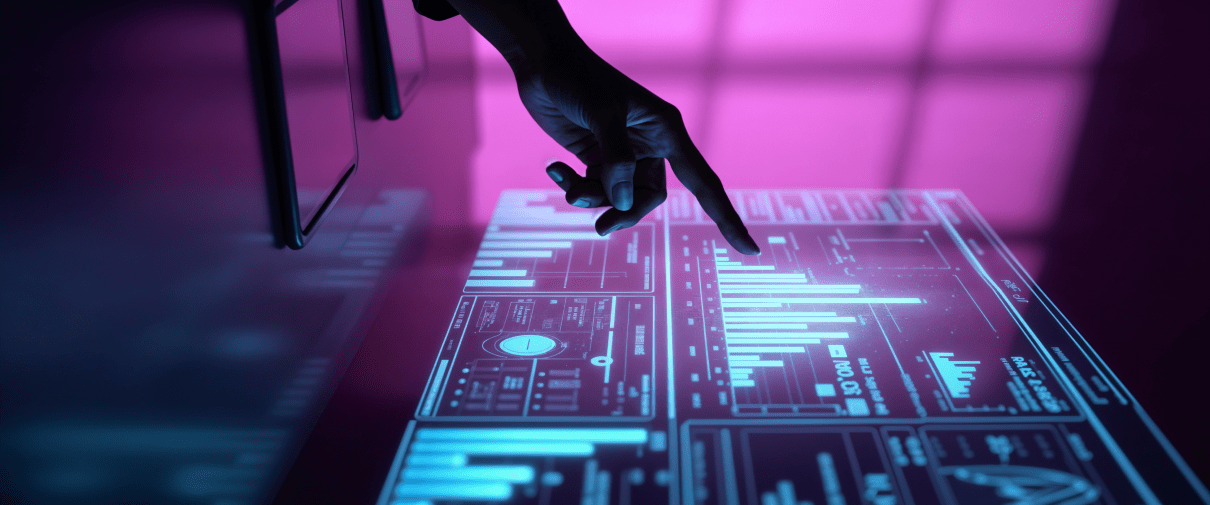Computer Vision
Tauchen Sie tiefer ein und entdecken Sie mehr mit dem Potenzial von Computer Vision.

Tauchen Sie tiefer ein und entdecken Sie mehr mit dem Potenzial von Computer Vision.
Computer Vision ist ein Bereich der Künstlichen Intelligenz, der mit Computern und Systemen arbeitet, die Informationen aus Videos, Fotos und anderen visuellen Daten erhalten. Künstliche Intelligenz ist das Gehirn des Systems, und Computer Vision sind seine Augen.
Es gibt unzählige Beispiele für Computer Vision, die seine Vorteile zeigen und neue Skalierungsmöglichkeiten für Unternehmen schaffen. CV wird seit Jahren aktiv eingesetzt, und wir können beobachten, wie es funktioniert und welche Ergebnisse seine Implementierung bringt.
HUMAN VISION VS COMPUTER VISION
HUMAN VISION SYSTEM


AUGE
(ein Sinnesorgan, das Bilder der Umgebung aufnimmt)

GEHIRN
(ein interpretierendes Organ, das für das Verstehen des Bildes und dessen Kontext verantwortlich ist)

Computer VISION SYSTEM


SENSORGERÄT (Kamera)

INTERPRETATIONSGERÄT (Computer)

AUSGABE
Kurzstatistik
Laut der Veröffentlichung von Statista wird angenommen, dass::
- Die Marktgröße im Bereich Computer Vision wird voraussichtlich 2024 26,26 Milliarden US-Dollar erreichen.
- Die Marktgröße wird eine jährliche Wachstumsrate (CAGR 2023–2030) von 12,56 % aufweisen, wodurch das Marktvolumen bis 2030 auf 50,97 Milliarden US-Dollar ansteigen wird.
Wir verfügen über Erfahrung in diesen Fachbereichen
Bilderkennung
Sie können Bilderkennung in Ihrem Unternehmen nutzen, wenn Sie Bilder erkennen und analysieren müssen, um bestimmte Aufgaben zu automatisieren. Die Funktionen dieser Technologie umfassen die Kategorisierung von Bildern in spezifische vordefinierte Gruppen von Klassen oder Arten von Elementen, die für Bilder charakteristisch sind. Auf Basis dieser Kategorisierung und Analyse zieht die Bilderkennung bestimmte Schlussfolgerungen, um verschiedene Aufgaben zu lösen.
Semantische Segmentierung
Semantische Segmentierung ist eine Technik der Computer Vision, die ein Bild auf Pixelebene analysiert und klassifiziert, um Objekte darauf zu identifizieren. Diese Technik versucht, die Kategorie jedes Pixels im Bild zu bestimmen. Das heißt, die semantische Segmentierung klassifiziert ähnliche Objekte als eine einzige Klasse auf Pixelebene.
Texterkennung oder OCR
Wenn Sie eine Lösung benötigen, die Text in einem Bild erkennt, ist Amanzium Company bereit, dies durchzuführen. Texterkennung oder OCR bezieht sich auf das Gebiet der Computer Vision, das für das Lesen von Text in Bildern, das Erkennen von Zeichen und damit für die Identifizierung von Text verantwortlich ist. Letztendlich wird der Text in eine maschinenlesbare Form umgewandelt, die für die Datenverarbeitung verwendet werden kann.
Instanzsegmentierung
Instanzsegmentierung ist eine fortgeschrittene Technik, die Objekte in Bildern auf Pixelebene klassifiziert und jede Instanz des Objekts identifiziert. Instanzsegmentierung klassifiziert ähnliche Arten von Objekten in verschiedene Kategorien. Diese Technik der Computer Vision verwendet Mask R-CNN-Strukturen, die ihr helfen, zwischen Instanzen innerhalb desselben Objektbildes zu unterscheiden.
Gesichts- und Personenkennung
Gesichtserkennung ist ein Teil der Objekterkennung, wobei das Hauptobjekt hier das menschliche Gesicht ist. Der Algorithmus sucht nach gemeinsamen Merkmalen und basiert auf einzigartigen Punkten wie Augen, Lippen oder Nase, um das Gesicht anhand dieser Orientierungspunkte zu klassifizieren. Es gibt verschiedene Methoden, um diese Art von Aufgabe zu lösen. Eine der traditionellen Methoden der Bildverarbeitung für die Gesichtserkennung ist der Haar-Cascade-Algorithmus. Andererseits zeigen Deep-Learning-Algorithmen, die CNN-Netzwerke verwenden, zuverlässigere und effizientere Ergebnisse.
Es gibt zwei Arten der Objektverfolgung:
- Einzelobjektverfolgung
- Mehrere Objekte verfolgen
Datenwissenschaftler verwenden zwei Methoden zur Objektverfolgung:
- Generativ: Das System identifiziert das Objekt anhand seiner unterscheidenden Merkmale.
- Diskriminativ: Computer Vision wird verwendet, um das Objekt vom Hintergrund zu unterscheiden.
Gesichts- und Personenkennung
Objektverfolgung ist eine Technik, die verwendet wird, um Objekte in einem Bild oder Video zu verfolgen, nachdem sie erkannt wurden. Nach der Bestimmung der Startposition kann der Computer im Online- oder Offline-Modus die Verschiebung in jedem nachfolgenden Frame vorhersagen.
Warum brauchen Sie Computer Vision?
Lösungen
Lösungen basierend auf Computer Vision helfen Ihnen dabei, Lieferungen effizienter zu gestalten, Lagerbestände zu verfolgen und Produktfehler oder Verzögerungen im Produktionsprozess zu erkennen. Dadurch steigern Sie die Produktivität Ihres Unternehmens, reduzieren Abfall und erhöhen Ihren Gewinn.
Kundenspezifische Dienstleistungen
Unternehmen können Computer Vision nutzen, um ihre Produkte und Dienstleistungen an die Vorlieben und Aktionen ihrer Kunden anzupassen. Sowohl das Kundenerlebnis als auch die Kundenloyalität können davon profitieren.
Produktivität steigern
Computer Vision ermöglicht eine Produktivitätssteigerung in verschiedenen Branchen durch die Automatisierung von sich wiederholenden Aufgaben und die Verbesserung der Genauigkeit.
Hohe Effizienz
Computer Vision hat auch seine hohe Effizienz bei der Betrugserkennung bewiesen. Durch die Analyse von Daten aus Sicherheitskameras und Transaktionsaufzeichnungen können potenzielle Betrüger identifiziert und betrügerische Aktivitäten verhindert werden, indem Trends und Anomalien in den Daten erkannt werden.
Automatisiert durch Computer
Eine Vielzahl von Aufgaben, die zuvor menschliches Eingreifen erforderten, kann durch Computer Vision automatisiert werden, darunter Bestandsmanagement, Sicherheitsüberwachung und Qualitätskontrolle in der Fertigung.
Computer Vision & Business-Lösungen
- Einzelhandel
- Unterhaltung
- Bildung
- Bankwesen
- Fitness und Sport
- Landwirtschaft
- Fertigung

Bargeldlose Geschäfte, automatisierte Waagen und Sensorsysteme zur Erkennung fehlender Produkte optimieren die Arbeitsabläufe der Mitarbeiter und ermöglichen ihnen, mehr Zeit mit den Kunden zu verbringen.
E-Commerce hat die bisherigen Erfahrungen der Kunden genutzt, um personalisierte Angebote zu erstellen und sie so zu weiteren Käufen zu motivieren. Und dies sind nur einige der Möglichkeiten, die mithilfe von Computer Vision gelöst werden können.

Computervision wird in interaktiven Unterhaltungssystemen eingesetzt, um unglaublich immersive Erlebnisse zu schaffen. Künstliche Intelligenz wird von modernsten Unterhaltungstechnologien genutzt, um den Nutzern Zugang zu dynamischen Erlebnissen zu ermöglichen.
Ein Beispiel dafür, wie Nutzer Informationen über das, was sie sehen, direkt erhalten können, sind Google Glass und andere intelligente Brillen. Das Sichtfeld des Nutzers erhält die Informationen direkt. Nutzer können Befehle einfach durch Kopfdrehungen geben, da diese Geräte auf Kopfbewegungen und Veränderungen der Gesichtsausdrücke reagieren können.

Die COVID-19-Pandemie hat der Fernbildung einen Aufschwung verliehen, und infolgedessen nutzt der EdTech-Sektor Computer Vision für eine Vielzahl von Zwecken. Zum Beispiel verwenden Lehrkräfte Computer-Vision-Tools, um das Lernen der Schüler auf eine nicht störende Weise zu bewerten. Mit diesen Tools können Pädagogen unaufmerksame Schüler identifizieren und ihren Unterricht so anpassen, dass diese aufholen können.
Darüber hinaus wird KI-Vision für Aufgaben wie regelmäßige Bewertungen, Wissensvermittlung, Anwesenheitsüberwachung und logistische Unterstützung von Schulen eingesetzt. Mit Computer-Vision ausgestattete Webcams, die zur Überwachung der Schüler während Prüfungen verwendet werden, sind ein typisches Beispiel dafür. Dies erleichtert die Erkennung unfairer Praktiken durch die Untersuchung von Körpersprache und Augenbewegungen.

Computervision bietet der Finanzdienstleistungsbranche zahlreiche Möglichkeiten, insbesondere im Bereich der digitalen Transformation. Die folgenden Bereiche sind für Banken und andere Finanzinstitute von Interesse:
- Dokumentendigitalisierung: für eine schnellere Datenerfassung und -verarbeitung
- Gesichtserkennung: für ein höheres Maß an Sicherheit und Unterstützung beim Know-Your-Customer-Prozess (KYC)
- Schadensbewertung: für Versicherungsanbieter, die Immobilien und Fahrzeuge abdecken
Banken können Computervision-Technologie nutzen, um eine Fülle nützlicher Daten zu generieren, die ihnen helfen, ihre Abläufe zu optimieren und die Kundenzufriedenheit zu steigern.

Sie können mehr Ergebnisse erzielen und jeden Spieler besser verstehen, indem Sie einfach die Leistungskontrolle, die Anpassung der Intensität und den Vergleich der erzielten Ergebnisse implementieren. Darüber hinaus können Sie die Spieler und den Ball auf dem Spielfeld verfolgen, sodass der Schiedsrichter genaue statistische Schlussfolgerungen ziehen kann.

Altmodische Methoden und Geräte verschwinden allmählich aus landwirtschaftlichen Regionen weltweit. Computer Vision wird heute von Landwirten genutzt, um die landwirtschaftliche Produktivität zu steigern. Fortschrittliche Computer-Vision- und KI-Modelle werden von Unternehmen für Agrartechnologie für Aussaat- und Erntezwecke entwickelt. Diese Lösungen können auch für erweiterte Wetteranalysen, Unkrautbekämpfung und Pflanzengesundheitsüberwachung eingesetzt werden.
Zahlreiche aktuelle und zukünftige Anwendungen von Computer Vision in der Landwirtschaft umfassen Ertragsverfolgung, autonome Schädlingsbekämpfung, drohnenbasierte Feldüberwachung, intelligente Sortierung und Klassifikation von Feldfrüchten sowie automatisiertes Sprühen von Pestiziden. Für zusätzliche Analysen scannen diese KI-gestützten Lösungen die Form, Farbe und Textur der Pflanzen. Wetteraufzeichnungen, Forstdaten und die Sicherheit auf dem Feld werden ebenfalls zunehmend durch Computer-Vision-Technologie optimiert.

Die Fertigung ist einer der technologisch anspruchsvollsten Prozesse in der modernen Welt. Computer Vision ist in Produktionsstätten weit verbreitet und wird häufig in KI-gestützten Inspektionssystemen eingesetzt. Solche Systeme sind in F&E-Labors und Lagern weit verbreitet und ermöglichen es diesen Einrichtungen, intelligenter und effizienter zu arbeiten. Zum Beispiel nutzen vorausschauende Wartungssysteme Computer Vision in ihren Inspektionssystemen. Diese Werkzeuge minimieren Maschinenausfälle und Produktfehler, indem sie die Umgebung kontinuierlich überwachen. Wird ein möglicher Ausfall oder ein minderwertiges Produkt erkannt, benachrichtigt das System das Personal, sodass weitere Maßnahmen eingeleitet werden können. Darüber hinaus wird Computer Vision von Mitarbeitern in der Verpackung und Qualitätsüberwachung eingesetzt.
Fachliche Expertise
Mit vielen Jahren Erfahrung in der Zusammenarbeit mit Kunden aus der ganzen Welt verfügen unsere Entwickler über tiefgreifende Fachkompetenz in der Entwicklung fortschrittlicher Technologien für verschiedene Geschäftsnischen.
Fertigung
EDTECH
FINTECH
REAL ESTATE
Gesundheitswesen
Handel
Logistik
Automobilindustrie
AGRITECH
E-COOMERCE
